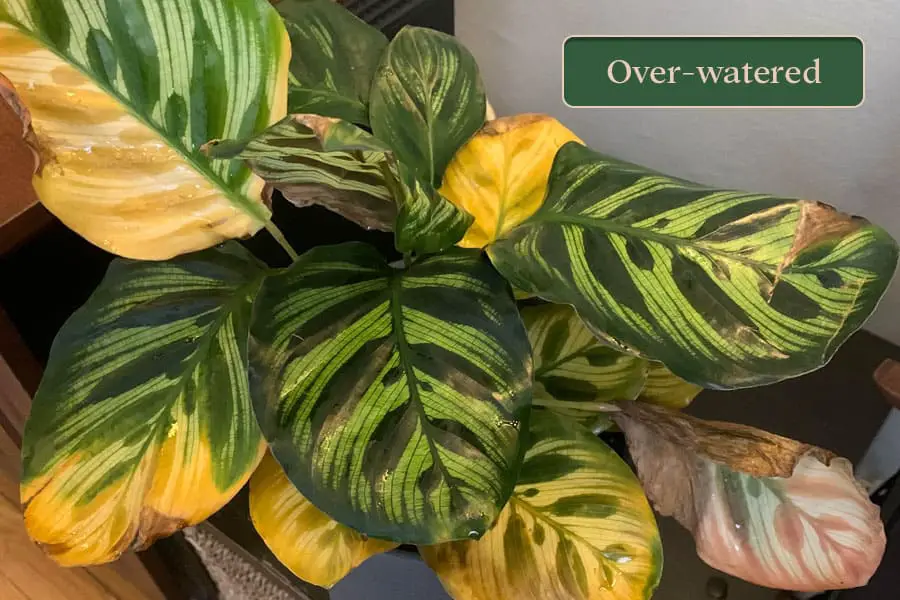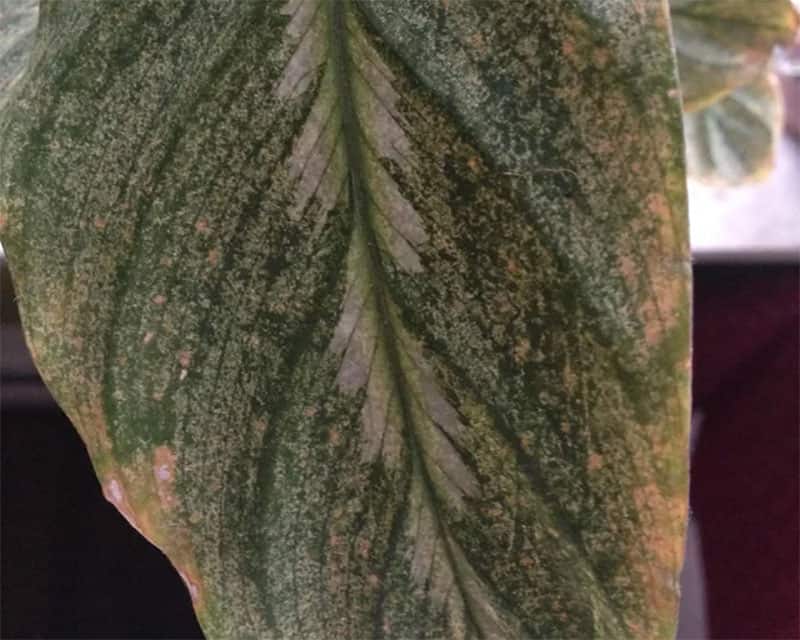Calathea plants are popular due to their beautiful and vibrant foliage. That’s why when the leaves suddenly turn yellow, Calathea owners would panic.
Calathea yellowing leaves are a sign of stress. This may be caused by a range of factors such as improper watering, harsh direct sunlight, cold temperature, over-fertilization, pest and diseases. It is essential to check for accompanying signs to determine the cause accurately.
Below is a list of the common causes for Calathea leaves to turn yellow. I will discuss further how to diagnose and quickly fix these problems accurately:
- Overwatering
- Dehydration
- Direct Sunlight
- Extreme Cold Temperature
- Over-Fertilization
- Spider mites Infestation
- Fusarium Disease
Let’s get started!
Steps to Check for the Right Causes of Yellowing
A yellowing leaf is often a symptom of one or more factors. Below are steps to start your diagnosis process:
Step 1: Look for Unwelcome Critters
Pests can be one of the causes of calathea leaves turning yellow. Although it is not always easy to fix, it is usually the easiest to identify.
Check both the top and the underside of the leaves for tiny crawlers or signs of webbing. If you find any, it means that pest infestations cause leaf yellowing.
Step 2: Check other symptoms on the leaves
Next, if you did not find any signs of pests on the leaves, you should look for accompanying symptoms other than just the yellowing.
For example,
Yellowing accompanied by drooping and curling of the leaves could indicate underwatering. In contrast, yellowing only on the edges of leaves can tell you that there is a nutrient deficiency.
Check all parts of your Calathea for clues to what may be causing the yellow leaves.
Step 3: Check the roots
If the yellowing leaves are the only symptom, you may want to inspect what is going on underneath the soil.
Take your prayer plant out of its pot and examine both its soil and roots for signs of root rot. Root rot is often the most difficult to handle and must be addressed quickly to save the plant.
Possible Causes of Calathea Leaves Turning Yellow
Now that you’ve identified the signs of the yellowing on your Calathea, let’s explore what caused it and how to fix it.
1. Overwatering
Overwatering is one of the most common causes of yellowing leaves on Calathea.
Waterlogged soil has little to no oxygen supply, thus interfering with water and nutrient uptake and photosynthesis.
If you left your Calathea on waterlogged soil for too long, the roots would start to develop rot.
The plant will still lose water through transpiration but cannot absorb any of the replacement supply of water from the damaged roots.
Signs of Overwatering

You might confuse the symptoms of overwatering with underwatering, as both can cause leaves to turn yellow.
However, the main difference is overwatered Calathea leaves will feel soft and limp when touched. In contrast, Prayer plants that are underwatered feel dry and crispy.
Treatment for Overwatered Calathea
- Adjust watering schedule – If you’re watering your Calathea too often, more than once a week, then you’ve likely overwatered it. If you’re unsure how often to water your Calathea, make sure the top 2 inches of soil are dry before watering again.
- Provide better soil and pot drainage – Your potting soil might be too compact. If this is the problem, you need to repot your prayer plant into a new soil mix with good drainage and aeration. And don’t forget to make sure that your pot has a drainage hole at the bottom.
2. Dehydration
While you want to avoid overwatering, you also need to ensure that you do not underwater your Calathea.
Calathea plants will start curling their leaves when they do not have enough water supply from the soil.
After a long period of dehydration, the chlorophyll on leaves will break down, turning from their original green color to yellow.
Signs of Underwatering

Apart from the yellowed leaves, you can identify underwatered Calathea plants based on their dry, brown leaves tips and droopy appearances.
Treatment for Dehydrated Calathea
- Make sure to water weekly – As I mentioned earlier, you need to water Calathea plants once a week. Drench the soil until water flows out of the drainage hole.
- Add mulch to the soil if it dries out too quickly – Mulch helps to keep moisture well. I usually add pine bark or coco coir to my potting soil to help retain water.
3. Direct Sunlight
As you may know, Calathea is a tropical plant that typically lives under the canopy of the rainforest. They prefer bright, indirect light.
If you leave your Calathea plant in direct sunlight for an extended period, the leaves will start to show signs of sunburnt that won’t recover.
Although it does not look appealing, a Calathea plant will be fine if it’s relocated to a space with shade.
Signs of Scorched Calathea Leaves
Usually, only the top leaves that are exposed to bright direct sunlight will appear sunburned.
The scorched leaves will develop patches of black shrivelling edges with yellow rings around the affected areas.
Treatment for Scorched Calathea Leaves
- Prune the affected leaves – If you do not like the appearance of the burned leaves, you can always trim them off. Pruning encourages the plant to use its energy on producing new leaves.
- Provide shade for the plant – You should position your Calathea plant about five feet from a window opening. If you are getting too much direct sunlight, you can filter it by using sheer curtains.
4. Extreme Cold Temperature
Originally from Brazil, Calathea prefers optimal temperatures in the range of 62ºF to 81ºF (16ºC to 27 °C). When the temperature dips below this range, prayer plants will be stressed and may develop yellow coloring.
As winter approaches, Calathea plants enter dormancy and stop producing food. Their chlorophyll breaks down, turning the leaves yellow.
Signs of Cold Stress
Besides the yellowing of leaves, a cold stressed Calathea plant might show signs of droopiness and wilting. In some cases, edges on its leaves may appear to be burned.
How to Treat Cold Stressed Calathea Plants
- Move outdoor Calathea indoors – If you grow potted Calatheas outside, they should be moved indoors when winter approaches. Moving them indoors means you can control your temperature better using a heat mat.
- Protect Outdoor Calathea from Frost – If your Calathea is growing on your garden outside, then you will need to cover them with a frost blanket or bucket as the temperature drop below 62ºF (16ºC).
- Keep it away from drafty windows – Short periods of intense cold can quickly stress out your plants.
- Use grow lights – Bright sunlight can be hard to get during winter. You might need to consider purchasing LED grow light to supplement your indoor Calathea plant.
5. Over-Fertilization
Calathea plant does not require heavy fertilization; over-feeding will accumulate salt build up around the root, making it hard for Calathea to absorb water.
Over-fertilizing can cause a similar effect to dehydration on your Calathea plants; their leaves will start turning yellow.
Although rarely happen, Calathea leaves will develop chlorosis and turn pale yellow when they are undernourished.
Signs of Over Fertilization
As Calathea are struggling to absorb water moisture, you may mistake their droopy yellow leaves for underwatering.
However, you can easily recognize overfeeding by the white crust residue it leaves on your potting soil.
How to Avoid and Fix Over-Fertilization
- Use half of the recommended dose – If the amount of fertilizer is still causing your leaves to turn yellow, dilute it further with water.
- Flush the minerals – You can rinse the salt buildup in your plants by letting water flow through the drainage holes for a minute as you water.
6. Spider mites Infestation
Although Calathea plants are susceptible to infestation from most common pests, they are especially prone to spider mites.
Spider mites feed on Calatheas tissues and sap, leaving tiny yellow spots. Over time, as the infestation gets worse, most of the leaves will start to turn yellow.
Signs of Spider mites Infestation

If you notice tiny white dots on your Calathea leaves, quickly check the underside of the leaf for spider mite webbings.
Treatment for Spider mite Infestation
- Isolate the plant – When you detect spider mites on your Calathea plants, the first thing to do is isolate them, so they don’t spread.
- Use Insecticidal soap and horticultural oils – these products are very effective to kill soft-bodied insects such as spider mites, thrips and aphids. You should apply these on both sides of the leaves.
- Increase humidity around the plants – Spider mites like dry air, so if you want to avoid an infestation, it’s best to buy a humidifier and improve the moisture in the air.
7. Fusarium Disease
Another thing that can cause yellowing on Calathea leaves is when it has been infected with Fusarium Wilt.
Fusarium is a type of fungus that leads to the drooping of older, lower leaves. This condition follows by stunting, yellowing, defoliation and eventually plant death.
How to Treat Fusarium Wilt
- Remove the affected leaves – Immediately prune the infected leaves to avoid spreading the disease to neighbouring plants.
- Apply fungicide – spray the entire plant with a fungicide and check again in a few days. If you have more leaves affected with fusarium, it is advised to dispose of the plant.
